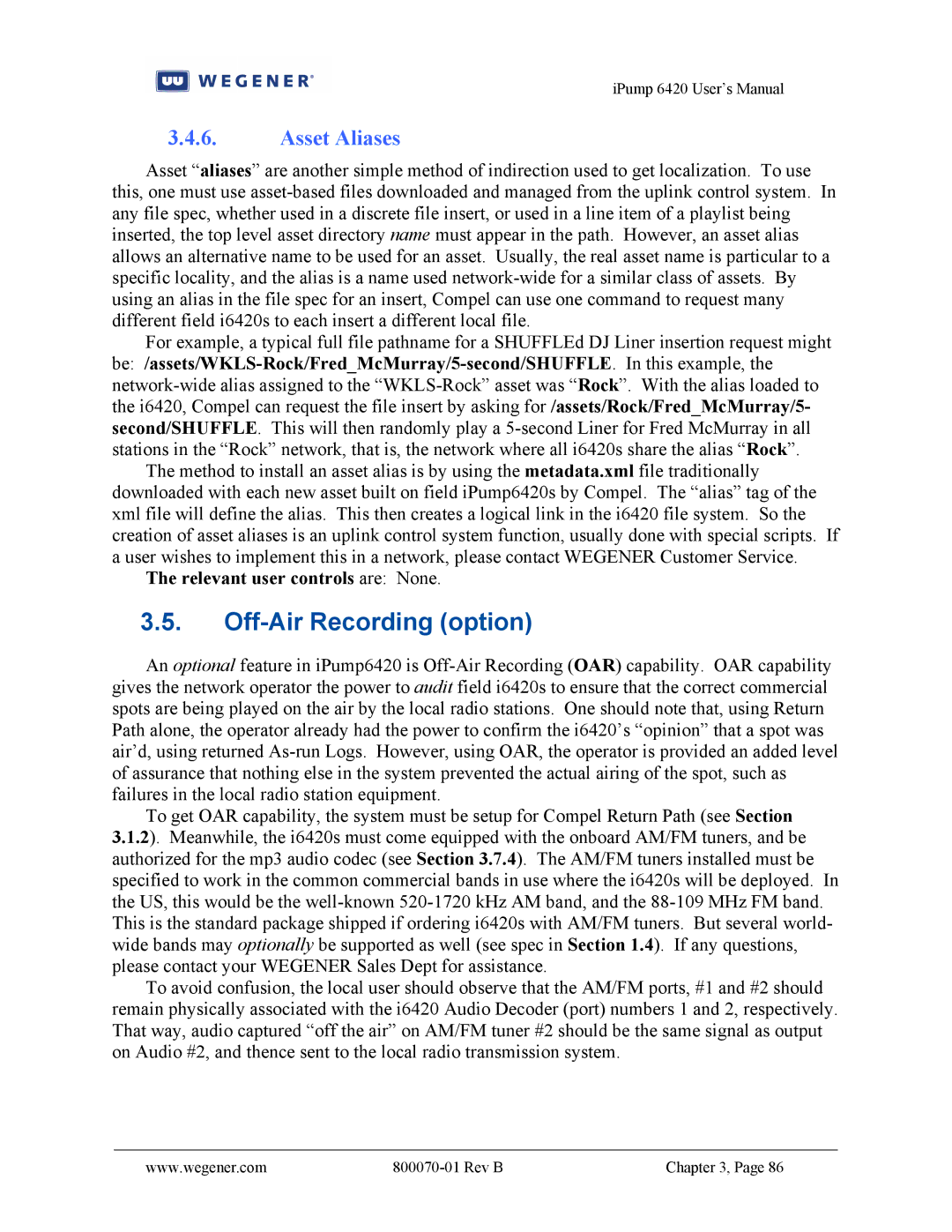iPump 6420 User’s Manual
3.4.6.Asset Aliases
Asset “aliases” are another simple method of indirection used to get localization. To use this, one must use asset-based files downloaded and managed from the uplink control system. In any file spec, whether used in a discrete file insert, or used in a line item of a playlist being inserted, the top level asset directory name must appear in the path. However, an asset alias allows an alternative name to be used for an asset. Usually, the real asset name is particular to a specific locality, and the alias is a name used network-wide for a similar class of assets. By using an alias in the file spec for an insert, Compel can use one command to request many different field i6420s to each insert a different local file.
For example, a typical full file pathname for a SHUFFLEd DJ Liner insertion request might be: /assets/WKLS-Rock/Fred_McMurray/5-second/SHUFFLE. In this example, the network-wide alias assigned to the “WKLS-Rock” asset was “Rock”. With the alias loaded to the i6420, Compel can request the file insert by asking for /assets/Rock/Fred_McMurray/5- second/SHUFFLE. This will then randomly play a 5-second Liner for Fred McMurray in all stations in the “Rock” network, that is, the network where all i6420s share the alias “Rock”.
The method to install an asset alias is by using the metadata.xml file traditionally downloaded with each new asset built on field iPump6420s by Compel. The “alias” tag of the xml file will define the alias. This then creates a logical link in the i6420 file system. So the creation of asset aliases is an uplink control system function, usually done with special scripts. If a user wishes to implement this in a network, please contact WEGENER Customer Service.
The relevant user controls are: None.
3.5.Off-Air Recording (option)
An optional feature in iPump6420 is Off-Air Recording (OAR) capability. OAR capability gives the network operator the power to audit field i6420s to ensure that the correct commercial spots are being played on the air by the local radio stations. One should note that, using Return Path alone, the operator already had the power to confirm the i6420’s “opinion” that a spot was air’d, using returned As-run Logs. However, using OAR, the operator is provided an added level of assurance that nothing else in the system prevented the actual airing of the spot, such as failures in the local radio station equipment.
To get OAR capability, the system must be setup for Compel Return Path (see Section 3.1.2). Meanwhile, the i6420s must come equipped with the onboard AM/FM tuners, and be authorized for the mp3 audio codec (see Section 3.7.4). The AM/FM tuners installed must be specified to work in the common commercial bands in use where the i6420s will be deployed. In the US, this would be the well-known 520-1720 kHz AM band, and the 88-109 MHz FM band. This is the standard package shipped if ordering i6420s with AM/FM tuners. But several world- wide bands may optionally be supported as well (see spec in Section 1.4). If any questions, please contact your WEGENER Sales Dept for assistance.
To avoid confusion, the local user should observe that the AM/FM ports, #1 and #2 should remain physically associated with the i6420 Audio Decoder (port) numbers 1 and 2, respectively. That way, audio captured “off the air” on AM/FM tuner #2 should be the same signal as output on Audio #2, and thence sent to the local radio transmission system.
www.wegener.com | 800070-01 Rev B | Chapter 3, Page 86 |

